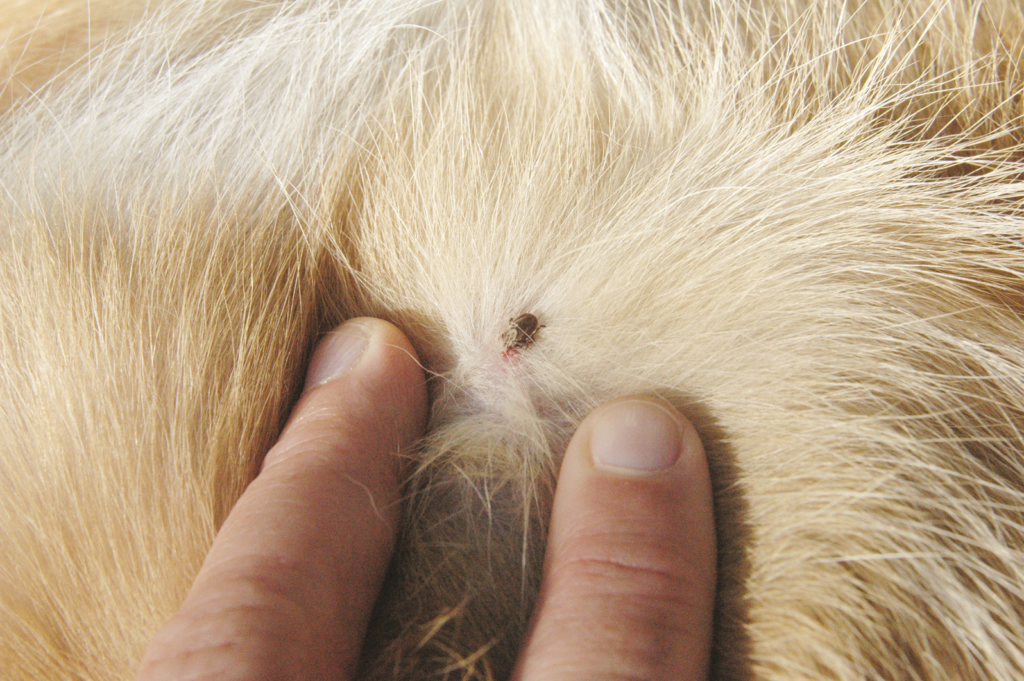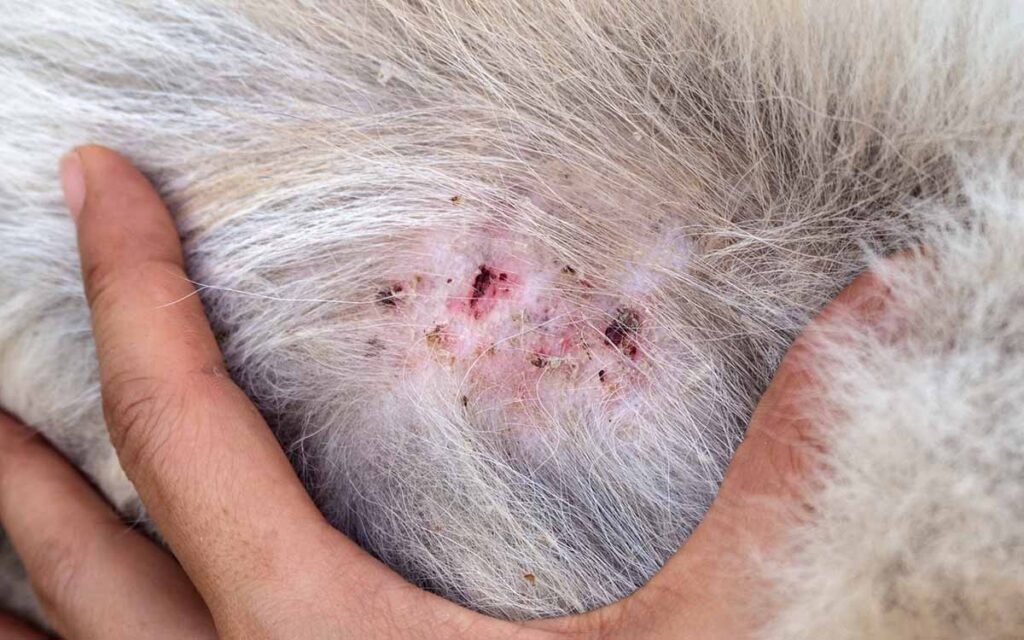Ticks can be a nuisance for both you and your beloved four-legged friend. Not only are they an annoying presence, but they can also spread disease and cause other health issues.
While it’s important to take preventative measures, such as flea and tick medicine and regular grooming, you may still find yourself dealing with ticks on your dog.
Knowing how to properly remove a tick, or “Tick Scrab On Dog”, is an important skill to have to ensure the safety of your pet.
In this blog post, we’ll discuss the steps to take when removing a tick from your dog.
How to Tell If Your Dog Has a Tick or a Scab

Dogs are prone to ticks and scabs, and it is important to be on the lookout for them. To protect your pet, you should regularly inspect your dog’s fur for any small bumps or scabs that may indicate a tick or scab.
Additionally, look for signs of irritation or scratching around the area, as well as any signs of redness, swelling, or pus. Take a close look at your dog’s skin for any small dark spots that could indicate a tick. Pay close attention to your dog’s behavior too—if they seem to be scratching or biting at the area, it may be a sign of a tick or scab.
It is important to take preventive measures to ensure your pet does not get ticks or scabs. Be sure to regularly inspect your pet for any ticks or scabs that may have gone unnoticed. If you find a tick or scab, take your pet to the vet to have the problem treated.
Finally, be sure to take the proper precautions to prevent ticks and scabs from occurring in the future. This may include giving your pet regular flea and tick medication and keeping them away from tall grass and wooded areas.
By taking these steps, you can help protect your pet from the nuisance of ticks and scabs.
Where Do Scabs on My Dog Come From?
Ticks can be found in wooded areas or in grassy areas and can easily attach to your dog’s fur and skin. The best way to prevent tick scabs is to use flea and tick prevention methods such as monthly topical treatments or collars.
If you notice a scab on your dog, it is important to check for ticks and remove them immediately.
If your dog has scabs due to tick bites, it is important to take them to the vet for proper diagnosis and treatment.
The vet can prescribe a topical medication or oral medication to treat the tick bite and the scab. They may also recommend a shampoo to help soothe the skin and prevent further itching and irritation.
How to Tell the Difference Between a Tick and a Skin Tag on Your Dog

Ticks and skin tags are often confused with one another due to their similar appearance. However, there are some key differences that can help you identify which is which.
Ticks are small, flat, dark-colored creatures that attach themselves to your dog’s skin. Skin tags, on the other hand, are small, flesh-colored growths that are not attached to the skin. Ticks have a round, hard body, whereas skin tags have a soft, fleshy appearance.
Ticks can be difficult to spot because they blend in with your dog’s fur. Skin tags, however, are more easily visible. To determine if a growth on your dog is a tick or a skin tag, use a pair of tweezers to carefully grab hold of the growth. If it moves away, it is likely a tick. If it does not move, it is likely a skin tag.
If a tick is found, use tweezers to carefully grasp the tick and pull it away from the dog’s skin. Do not attempt to squeeze the tick as this can cause its head to remain embedded in the skin. It is recommended that you also consult with a veterinarian to ensure the tick is completely removed and that your dog is not at risk for any diseases.
Should I Worry About a Skin Tag on My Dog?
Skin tags can occur naturally on dogs, just like they do with humans, and in most cases, they’re harmless. However, if the skin tag is large, it could be a sign of a more serious health issue. Depending on the size, shape and location of the skin tag, it could be a tumor, a cyst or even a tick.
If the skin tag appears to be growing or changing in any way, it’s important to have it checked out by your veterinarian.
Your vet may be able to determine whether the skin tag is benign or if it requires further testing. If the skin tag is a tick, your veterinarian may need to remove it and begin treatment for any potential tick-borne diseases.
It’s important to regularly check your dog for ticks and keep up on flea and tick prevention to reduce the chances of a skin tag forming. Be sure to examine your dog regularly for any suspicious lumps or bumps, and if you ever notice a skin tag, contact your veterinarian for a professional opinion.
My Dog Has a Tick — How Do I Remove It?
Ticks can be a real problem for dog owners, as they can carry various diseases and infections. It is important to understand the importance of removing a tick from your dog as soon as it is discovered. It is also important to use the correct materials and techniques to ensure the safety of your pet.
To begin, gather the proper materials to safely remove the tick, including tweezers, rubbing alcohol, and a container.
Use the tweezers to firmly grasp the tick close to the skin, and then pull it out in a slow and steady motion. After the tick has been removed, dispose of it in the sealed container and wash your hands with soap and water.
Next, clean the area where the tick was with rubbing alcohol to prevent infection and irritation. Monitor your dog for any signs of illness or infection, including fever, lethargy, or loss of appetite. If any of these signs appear, talk to your vet and keep up with regular tick prevention measures.
By removing the tick quickly and safely, and keeping up with regular tick prevention, you can ensure the health of your pet and protect them from tick-borne illnesses.
Can Ticks Make My Dog Sick?

Ticks can transmit a wide range of diseases to our canine companions, including Lyme disease, Rocky Mountain spotted fever, and ehrlichiosis.
Not only that, but ticks can also cause a condition called tick paralysis, which can be fatal if not treated promptly.
This highlights the importance of checking your dog for ticks after any outdoor activities and removing them immediately to prevent illness.
Regular tick scrubs can help reduce the risk of ticks making your dog sick. But even with preventive measures, it is still possible for your dog to contract a tick-borne illness.
Some signs that your dog may be suffering from one of these conditions include lethargy, fever, vomiting, joint pain, and loss of appetite. If you notice any of these symptoms, take your dog to the vet immediately for a check-up and treatment.
In short, ticks can be a real problem for pet owners and it is important to take preventive measures such as regular tick scrubs and prompt removal of any ticks found on your dog. When in doubt, it is always best to take your dog to the vet for a check-up.
Tick Prevention
To prevent ticks, it is important to use topical flea and tick preventative treatments on your dog on a regular basis. You can also apply tick collars, tick sprays, or flea and tick shampoo to your dog when bathing them.
Additionally, it is important to inspect your dog for ticks after walks in wooded or grassy areas and to look for signs of ticks such as scabs, ticks, or bumps on their skin.
To further reduce the risk of tick infestation, make sure your yard is free of leaves, tall grass, and debris, as these can provide a home for ticks. Additionally, try to avoid letting your dog sleep in tall grass or in wooded areas.
If you are concerned about ticks on your dog or preventing tick infestations, it is important to speak to your veterinarian about tick prevention treatments.
They can provide advice on the best products to use and a regular schedule for applying them. With the right preventative measures, you can help keep your dog safe from ticks.
Conclusion
Ticks are a major health concern for our pets and can cause serious illnesses if not caught early. To prevent ticks from infecting your pet, it is important to regularly check for ticks and perform tick scrab when necessary.
Tick scrab is the process of carefully removing the tick from your pet’s skin as close to the skin as possible. It is also important to make sure that no part of the tick remains in the skin.
After removing the tick, clean the area with soap and water or an antiseptic. If you find multiple ticks on your pet, contact a veterinarian for further advice.
In addition to regular tick scrab, it is important to help prevent tick infestations in the first place. To do this, try to keep your pet away from tall grass and wooded areas.
If your pet is out in these areas, perform a tick scrab when they get back home to ensure that they are free of ticks. By following these simple steps, you can help keep your pet healthy and reduce the risk of tick-borne illnesses.

